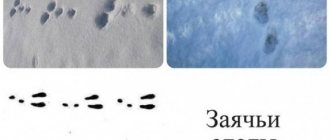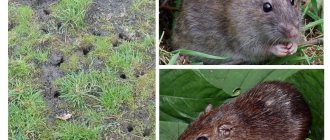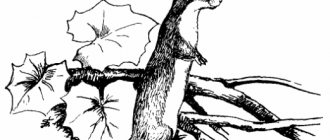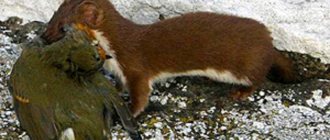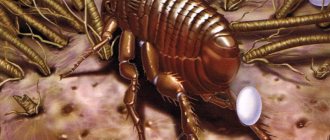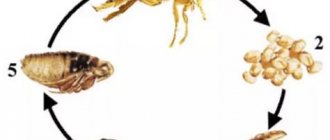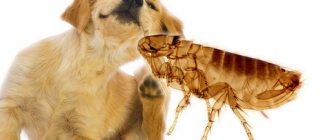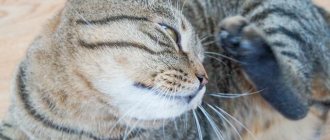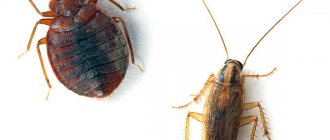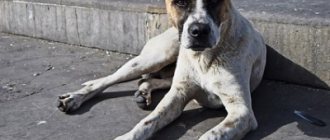Moose trail
It is difficult for an experienced hunter to confuse the tracks of an elk with the tracks of other animals. Of course, they are very similar to the hoof prints of cattle and some wild elk relatives, but they are significantly larger in size. The hooves of a male elk, even if of average build, are always larger than the hooves of the largest domestic bull. In general, the elk walks heavily and sinks deep into the loose snow, down to the ground. The stride length is usually about 80 cm. When trotting, the stride is wider - up to 150 cm, and when galloping, jumps can reach 3 meters. The width of the print, excluding the lateral toes, is about 10 cm for moose cows and 14 cm for bulls, and the length is 14 cm and 17 cm for females and males, respectively.
Photo of moose tracks in the snow added by user z.a.v.77. in 2017.
General information
For many, animal tracks are just paw prints or paths trodden by forest inhabitants, but for professional hunters, this is everything that the animal left on a certain section of its route.
It could be a broken or eaten branch, nut shells, or the remains of prey. Here you can see droppings, which is also a kind of trace. To detect burrows and nests of animals, bird nests, the hunter tries to obtain as much information as possible. Therefore, even a feather lost by a wild duck or hazel grouse or a piece of fur caught in a bush can tell an experienced tracker a lot.
Wild animals have excellent sense of smell, hearing and vision and also behave very carefully. Having noticed a person, they may not run away or fly away, but simply hide and wait. Therefore, the main key to unraveling the mysteries of the life of animals is, first of all, their traces.
Knowing and studying the tracks of wild animals, birds, insects and reptiles will make it possible not only to find out who you are dealing with, but also how old the track is and the direction of movement of the animal. All this together allows you to hunt effectively without being distracted by the animal’s old footprints, and also to eliminate unnecessary encounters with a predator. Skillful reading of animal prints significantly reduces hunting time. It’s good to have an experienced tracker when studying them, but even without one, with perseverance, you can achieve positive results.
Precise prints are clearly visible on wet, freshly fallen snow no more than 5 cm thick. At this time, you can familiarize yourself with the tracks using the example of domestic animals - cats, dogs, pigs, goats, cows, ducks, etc. There are features that need to be kept in mind:
- The tracks of a large dog are very similar to those of a wolf.
- Felines are similar to larger prints of their wild counterparts: jungle cat, lynx, leopard, tiger.
- The markings of a pigeon's paws are similar to those of a partridge.
- The tracks of a cow are similar to the outlines of the hooves of an elk, a large wild boar, etc.
Based on comparisons and comparisons, features of fingerprints are learned that simply could have gone unnoticed. By analyzing them, you can find out about the number of individuals, but not in the case of wolves. They have a specific ability to follow a trail.
hare trail
Hares leave two long hind paw prints in front and two shorter front paw prints behind them. In the snow, the length of the footprint of the front paws is about 8 cm with a width of 5 cm, and the length of the hind paws is up to 17 cm, with a width of about 8 cm. Due to their specificity, the tracks of the oblique are not difficult to determine, as is the direction of its movement. Hiding from pursuit, a hare can make jumps of up to 2 meters, and in a “calm environment” the length of the jump is about 1.2 - 1.7 meters.
A photo of hare tracks in the snow was added by Laichatnik in 2015.
Looking out for birds
What can you see?
The world of birds is much poorer in winter than in summer and during seasonal migrations.
However, it is in winter that you can see many birds that are difficult to see in summer. Birds that have not flown south gather in city squares and parks, in villages and holiday villages. First of all, these are birds that eat the seeds and pulp of fruits of trees and shrubs planted by humans. Some nest near homes in the summer, for example, the great tit ( Parus major
), blue tit (
Cyanistes caeruleus
), greenfinch (
Carduelis chloris
), fieldfare (
Turdus pilaris
) and blackbird (
Turdus merula
).
Other birds in such areas are found mainly in winter, for example - bullfinch ( Pyrrhula pyrrhula
), waxwing (
Bombycilla garrulus
), crossbill (
Loxia curvirostra
), siskin (
Spinus spinus
) and redpoll (
Acanthis flammea
).
There are rare birds that do not winter every year, or not in all parks, for example, the grosbeak ( Coccothraustes coccothraustes
), the chaffinch (
Fringilla coelebs
), and the robin (
Erithacus rubecula
).
In large parks and forests, as well as in holiday villages, jays and woodpeckers of various species are found. In almost every city square, a sparrowhawk ( Accipiter nisus
) sits in wait for tits, sparrows and pigeons, and closer to the forests, the small owl (
Glaucidium passerinum
) readily catches small birds.
Great tit ( Parus major
) is one of the most common wintering birds. In the metallic tint on the feathers one would like to see the justification for the name of this bird, however, these birds were nicknamed “tits” or “zinks” in imitation of their ringing voices, which well mark the approach of a flock of tits. The largest of our tits, the great tit dominates others in mixed flocks
Wikimedia Commons
Share
Many birds are found in flocks in winter.
Field thrushes and waxwings, siskins and redpolls, as a rule, do not mix with other birds, but tits often feed in mixed groups. Powder tits ( Poecile montanus
), black tits (
Periparus ater
), tufted tits (also known as grenadiers) (
Lophophanes cristatus
), kinglets (
Regulus regulus
), and long-tailed tits (
Aegithalos caudatus
) move together
nuthatches ( Sitta europaea
), pikas (
Certhia familiaris
), various woodpeckers. When you meet a flock, try to find and examine all its members. Although this is not easy if the birds climb high into the crowns of spruce trees.
Tufted tit ( Lophophanes cristatus
) often lives in mixed flocks, but does not often allow itself to be seen: it stays higher in the crowns than other tits, and flies to humans only to imitate alarm calls. Rarely leaves coniferous forests
Wikimedia Commons
Share
In wastelands and fallow lands, along the edges of fields, you can see goldfinches (
Carduelis carduelis
Lanius excubitor
) and rough-legged buzzard (
Buteo lagopus
hunt .
Along the sides of roads passing through fields, especially closer to the black soil strip, there are flocks of horned larks ( Eremophila alpestris
), snow buntings (
Plectrophenax nivalis
), and individual crested larks (
Galerida cristata
).
Bunting ( Plectrophenax nivalis
) in winter attire. The rufous edges of the coverts are clearly visible. They wear out over the winter, and the spring outfit of this bird becomes more contrasting.
Eric Begin/Flickr
Share
Many birds can be found in floodplains or along the banks of ice-free reservoirs.
Near open water, even in a small pond or ditch, a wren ( Troglodytes troglodytes
), robin, rail (
Rallus aquaticus
) or moorhen (
Gallinula chloropus
) can overwinter, and blackbirds (
Turdus merula
) will also feed there.
In a fast-flowing polynya, if you are lucky, you can meet a dipper ( Cinclus cinclus
) or a kingfisher (
Alcedo atthis
).
On small rivers, in addition to the well-known mallard ducks ( Anas platyrhynchos
), you can find the little grebe (
Tachybaptus ruficollis
), and on large rivers, for example, on the Moscow River - gray heron (
Ardea cinerea
), white-tailed eagle (
Haliaeetus albicilla
), great grebes (
Podiceps cristatus
).
On the Moscow River you can also see various ducks in their mating feathers - in addition to the mallard, these are goldeneye ( Bucephala clangula
), tufted duck (
Aythya fuligula
), great merganser (
Mergus merganser
), lutok (
Mergellus albellus
), long-tailed duck (
Clangula hyemalis
) and others , as well as gulls: common gull (
Larus canus
), silver gull (
Larus argentatus
) and southern laughing gull (
Larus cachinnans
). Many ducks, which can be seen so well in winter, hide better in summer, or fly north, and also change their plumage to duller ones.
Male goldeneye ( Bucephala clangula
). These ducks winter annually on the Moscow River, sometimes forming flocks of several dozen birds. Like other ducks, before the start of winter, the goldeneye puts on a fresh breeding plumage.
Wikimedia Commons
Share
How to walk and what to do?
Bird watching requires optics, optimally 8x or 12x binoculars. On the river, a telescope with a tripod will be very helpful. A field identification guide is also required, preferably a paper one; it is simply more reliable in the cold than any equipment. There are now many available qualifiers, both in Russian and in other languages. The best guide to the birds of the European part of Russia is Lars Svensson's Collins Bird Guide. To get acquainted with the winter fauna of the European part of Russia and Western Siberia, Vadim Ryabitsev’s guide “Birds of the Urals, the Urals and Western Siberia” is ideal, which describes in detail the behavior and biology of birds. A tablet or smartphone will help lure songbirds in the forest or reed thickets: they fly closer when they play singing or alarming cries. Often you don't even need a column. You can learn to lure the birds yourself: by imitating a squeak (various tits and robins, and sometimes even predators, respond), or by knocking on wood (woodpeckers fly up).
Birds are most active in the morning hours, so it is better to go out at dawn. Even on reservoirs, where the activity of birds is not so clearly tied to the time of day, there are fewer people and dogs in the morning hours, but in the afternoon and evening they can already scare away the birds. In order to get to know the birds in a certain area, you will need to create several routes: through populated areas and public gardens; through the forests; in open areas (fields, wastelands); along the banks of reservoirs.
Many birds can be attracted to the feeder. Among urban buildings, you can limit yourself to a simple set of food: unroasted sunflower seeds (tits, nuthatch, sparrows, bullfinch, greenfinch), dry white bread (robin, polovnik), mixture for caged birds (small seeds, accessible to siskin and redpoll), unsalted lard ( tits, woodpeckers), berries or pieces of fruit (waxwings). By placing a wide selection of delicacies on a feeder located near the forest, you can lure other birds. You just need to remember that birds of prey (sparrowhawk, pygmy owl) also stay near the feeders, lying in wait for small birds that have lost their caution.
Sparrowhawk ( Accipiter nisus
) regularly hunts birds near feeders. Its victims include not only tits and bullfinches, but also rock pigeons, which are close to the predator in size.
Wikimedia Commons
Share
Bird singing can rarely be heard in winter, so you should listen to the voices of birds even more carefully than in other seasons. Sometimes only barely audible screams allow one to detect a flock of birds. Hearing the squeaks of tits, you can also see birds of other species staying in a mixed cluster. Finally, loud, restless calls will alert you to the proximity of a feathered predator that other birds have discovered.
Fox trail
Fox tracks allow an experienced hunter to determine the nature of its movement. A fox paw print is typically about 6.5 cm long and 5 cm wide. The step length is from 30 to 40 cm. However, during a hunt or when escaping pursuit, the fox makes fairly long (up to 3 m) jumps and throws forward, to the right or left - at right angles to the direction of movement.
Photo of fox tracks in the snow added by user kubazoud in 2016.
Animal tracks. How to determine the trail of an animal.
How to determine the trail of an animal. Learning to recognize animal tracks.
How to learn to identify and distinguish animal tracks? How to distinguish, for example, the track of a wolf from the track of an ordinary dog or the track of a white hare from a hare? How to learn to track an animal? Read about all this below! A visual aid for identifying animal tracks with descriptions and pictures.
A bear's footprint (especially the hind paws) is similar to a human footprint (with the exception of claw prints). The male's trail is slightly wider than the female bear's, and therefore an experienced hunter can easily distinguish the gender of the passing animal. The place where the bear passed can be seen even in the summer, because the animal strongly crushes and tilts the grass in the direction of movement. In addition, in the summer a bear will never pass indifferently past anthills, stones, snags, etc., but will definitely stir them up or turn them over.
Bear trail
The tracks of a wolf resemble those of a large dog, but since the wolf clenches his fingers more tightly, the lower part of his fingers is more convex, and the track is therefore more elongated and is more clearly imprinted on the dirt or snow. The main difference is that the wolf's track is correct and its direction is straight. The animal walks in such a way that the imprint of the right front foot fits into the back left one and vice versa, so the tracks stretch in a line, each such track is approximately 30-35 cm from the other (depending on the depth of the snow and the age of the animal). If a pack is walking, then those following the first animal step “footstep in footstep”, so the number of wolves in the pack can be found out when the pack enters the forest.
The freshness of the footprint (unless there was powder) can be recognized by the looseness of the snow, crushed by the feet of the walking animal; if the trail is old, then it and its edges freeze and become hard to the touch. A fresh footprint has a so-called “drag” - a thin line between the tracks, which disappears after a few hours (it appears because the wolf drags its hind legs a little on loose snow). The wolf does not often walk at a walk, but usually at a small trot. This tread of the beast seems wrong, but despite this, the wolf uses it to lay the most correct trail. If a wolf is jumping (“waving”), then the trail of the hind paw is approximately three fingers distant from the corresponding front paw.
Wolf footprint on the ground (above) and on the snow (below)
A wolf's track can be easily distinguished from a dog's track if the track is fairly clear. A wolf's two middle fingers are located much further than the outer ones (if compared to a dog's track). The outer and middle fingers can be separated by an imaginary line, and this line will not intersect the prints of the outer fingers.
difference between wolf and dog tracks
comparison of wolf and dog tracks
The track of a fox resembles the track of a medium-sized dog, but the differences are also in the correctness of the gait and the tightness of the paw. Usually the fox steps in one line and, like the wolf, lays out the correct tape. The animal also walks to feed in two, very regular tracks, and can also move in four tracks, like a dog. The fox never makes a trail, and if it walks in a certain place for several days in a row, then each time it carefully follows the same trail. In addition, if she walks back in the same place, she rarely follows her oncoming trail, but tries to choose a different path.
The fox quite often makes loops, like the hare, but unlike the latter, it never takes notes. While lying down, she turns her head in the direction from which she came. It happens that an animal hides its tracks in a hare's trap. Experienced hunters are able to distinguish between the tracks of a male and a female - the male's is round and clean, while the female's is oblong, narrow and not so clean, since the female usually picks up the snow with her hind legs - scribbling.
fox trail
A lynx's track always has only one constant direction and is very similar to a cat's - it is round, with distinct fingerprints; in this case, the claws are imprinted only in the case of the fastest running.
lynx track
A moose footprint is larger than a deer one, and the cuts in the hoof diverge more widely. The moose always puts its legs straight and never “furrows.” Its droppings resemble those of a deer and consist of large hairs of a slightly oblong shape (but they are slightly rounder than those of a deer), which in males usually stick together, and in females fall apart. A bull's track is always rounder and larger than a moose's track.
elk trail
The trail of a wild boar resembles that of a domestic pig, only sharper than the latter. In its outline, it resembles the trail of a red deer (especially if the trail was left by an old cleaver). The difference between a boar track is that the rear appendages diverge in the shape of grouse braids. They are wider than the footprint itself, are printed together with the hooves without gaps, and the distance between the traces is less. The footprint of a male differs from that of a female - the wild boar has larger toes, and the hooves are blunter and the same on any leg. In pigs, the hooves are very different in size from one another and, in addition, the footprint of a boar is wider than that of a pig, since it swings its legs more to the sides when walking. The age of the animal can also be determined by the size and depth of the footprint.
Boar tracks in the snow
Animal tracks : (left), otter (center) and marten (right)
POROSHA
Powder is snow that fell at night and ended in the morning. Therefore, only fresh traces of animals that fattened at night are visible in the snow, which greatly simplifies tracking them. Real powder in central Russia usually occurs no earlier than the beginning of November. The powder is considered good if the snow is so deep that the footprint is clearly visible on it (and the footprint is continuous, that is, there are no large bare spaces.
The first powder is always formed by snowfall, the next ones can be a consequence of drifting snow. Therefore, powders can be upstream and downstream (drifted). But most often the powder is formed by the simultaneous fall of snow and drifting snow. Powders are divided by depth into fine, deep and dead. Small - if the prints of the hare's front paws are pressed no deeper than the lower joint; deep - if the snow falls to a depth of 10 to 15 centimeters, dead - when warm wet snow falls in an even layer 15-20 centimeters thick. Printed is called powder when each claw of an animal’s paw is clearly imprinted on the snow. Such powder occurs when shallow melting snow (warm powder) falls.
Warm powder does not deteriorate by the wind and therefore (unless it stops melting) can last the longest, since after warm powder you can look for fresh traces, very different from the blurred old ones, for two to three or even more days.
Depending on the duration of the night snowfall, the powder can be long or short. The long powder was snow, which quickly stopped, and therefore the animal managed to leave a lot behind. Conversely, a short powder is a short trail because the snow fell all night or even continues to fall. Deep (and especially dead powder) is certainly short, because the animal (especially the hare) always wanders a little. Regarding the noise that the hunter makes when approaching, the powder can be soft (in warm weather) and hard (in frosty weather, when the snow is loose). Hard powder is always inconvenient for approaching, because the noise made by the hunter scares the animal away.
Powder, good in the morning, can deteriorate or be destroyed by snowfall or drifting snow. In general, after a strong snow drift, tracking is rarely successful. In addition, you need to keep in mind that ground powder can only be in open places, so on the edge of the forest and in forest clearings in the wind, searching for fresh traces is very difficult. On the contrary, if the drifting snow continues to sweep, then the tracks in the field will be swept away, but under the forest they will be very clearly visible. In the steppes there is almost always wind, and therefore during the day the powder there usually always spoils (with the exception of warm weather).
Traveling powder is the kind of powder when dry snow, like fluff, falls on the frozen ground and does not give the dog any support for its paws while running. With such powder, a dog slides and runs across the frozen ground, as if on ice. Powder is very important for hunting animals, especially hare and also for gun hunters. They can track the beast on skis throughout the winter.
MALIK
Malik is the entire path of a hare, marked during the night in the snow, from its bed, where it spent the day, to the feeding area (the place where the hare fed), and back to the den. The ability to recognize a variety of hare tracks is very important, especially for those hunters who plan to hunt a hare by tracking.
It is quite difficult to track white hare, and therefore hare are more often “tracked”. It is difficult to see the white hare in winter when lying down; moreover, it very much confuses the passages and often lies down in a “strong” place. In addition, tracking hare is a very tedious task. He greatly confuses his moves, fills paths, runs into the tracks of other hare, circles and makes loops a lot. Therefore, in areas where both hare and hare are found, it is very important to be able to distinguish them by their tracks, which is achieved quite quickly.
From left to right: hare trail, hare trail on crust, hare trail, hare trail on crust
The white hare that lives in the forest, where the snow is slightly looser than in the field, has wider and more rounded paws, the toes spread wider, and the animal leaves footprints in the snow that resemble a circle; The hare's footprint is oval. When the snow is not so loose (with printing powder), individual fingerprints appear. But the hare's hind paw prints are still slightly wider than those of the hare. More elongated and parallel to each other and slightly ahead of each other, the hare's tracks belong to the hind legs, and those similar in outline to a circle and running one after the other, along a line, belong to the front legs.
From left to right: end tracks, end tracks with discounts, fat tracks, racing tracks, racing tracks with jumps
A sitting hare leaves a different mark. The prints of the front paws are located almost together, and the prints of the hind paws lose their mutual parallelism. Since the animal, when sitting, bends its hind legs to the first joint, then in the snow, in addition to its paws, the entire pasanka is also imprinted. (In the figure below, the prints of the hind paws with pazankas are shaded.) If we exclude this case (when the hare is sitting), then the prints of the hind paws always remain parallel to each other, and if tracks are noticed in which the prints of the hind paws go apart (i.e. clubfoot) ), then these are not hare tracks, but cats, dogs or foxes when they gallop. The same can be said about a footprint in which one hind paw is significantly ahead of the other.
footprint of a sitting hare
The normal track of a hare is large jumps. In this case, the animal puts out its hind legs almost simultaneously, and places its front legs one after the other. Only when the jumps are very large does the hare put his front paws almost together. The usual tracks of a hare are called end tracks, since with such measured jumps he goes to the fat and returns from it. The difference between fat marks and end marks is that the paw prints are not far apart from each other, and the individual marks practically merge. Such marks are called fat marks because animals leave them where they feed, moving slowly and often sitting down. The hare leaves marking marks (in other words, sweeping marks) in large jumps, which it makes at an angle to the original direction of movement.
With skimpy tracks, the hare tries to hide, interrupt his own trail, before he plans to lie down. Usually there are one or three “discounts”, occasionally four, after which the usual, terminal traces follow again. As a rule, before making a discount, the hare doubles its tracks. The hare's skid jumps differ from the end tracks in the distance between the tracks, and also in the fact that the prints of the front paws are located together. The hare makes rutting (restless) tracks when it is frightened from its den - and then the animal moves in big leaps. Racing tracks are very similar to jump tracks or end tracks (only in the opposite direction), since the prints of the front paws are closer to the prints of the hind paws of the previous, rather than the same jump.
cleft loop
From the place where the hare sat before dusk, the malik usually begins with fatty traces, which then turn into terminal ones. They sometimes go straight to the fats, where the hare always moves in small “steps”, often stops and sits down. After feeding, the hare sometimes runs and plays, and immediately comes across rutting tracks. Having run up, the animal feeds again, or already at dawn it moves from the fat along the trailing tracks to a new lair. Before choosing a reliable place to lie, the hare begins to meander, again crossing its previous tracks. Sometimes such loops occupy large areas. At point A, it is rarely possible to say with certainty, without turning the loop, that the tracks belong to the descending malik or that another hare passed here.
It is rare to see more than two loops. After them, “twos” and “threes” begin (doubling or building a trail). In this case, the traces can overlap each other, and here skill and ability are required to distinguish a double trace from a regular one. After a “two,” the hare most often makes a discount to the side, but after a “three” (rare), there are usually no marks, and the animal gallops on for a considerable distance. Usually, the hare's "twos" and "threes" are seen along roads or ridges of ravines, where, as a rule, there is little snow, and at the beginning of winter - in meadows, in hollows and on recently frozen rivers and streams. The length of the “twos” is variable and can vary from five to one hundred and fifty steps. “Deuces” indicate the proximity of the bed, and if a hare after a “two” with a discount goes a considerable distance, changing the discount tracks to the end ones, then this is, as a rule, an exceptional case.
Threes, as a rule, are not very long and the direction of the trail after them usually does not change (and very rarely they are followed by a discount). Almost always the hare “throws off” at a right angle to the direction of movement; after several discount jumps there are several end jumps and again a second “two” with discounts. Quite often, Russians are limited to just two “twos,” but there are maliks where the number of “twos” reaches eight or more.
Bear tracks
The tracks of a brown bear are quite easy to recognize among the tracks of other animals. This heavyweight (on average his weight is about 350 kg) cannot pass through snow and mud unnoticed. The prints of the animal's front paws are about 25 cm long, up to 17 cm wide, and the hind paws are about 25-30 cm long and about 15 cm wide. The claws on the front paws are almost twice as long as those on the hind paws.
Photo of bear tracks in the snow added by user willi in 2016.
Systematization of traces of forest inhabitants
To make it easier to decipher the tracks of forest animals, their classification has been made. Thanks to this, it is easier to figure out which animal left a characteristic mark in the snow. For example, representatives of the canine family leave covered prints in one line. The toe pads with claws are clearly visible on the soil or snow.
Animals such as the brown bear and badger leave a characteristic covered footprint with long claws and bare soles, the size of the front paws is smaller than the hind paws.
A badger's footprint is very similar to a bear's, only smaller in size.
The easiest way to understand is that one of the representatives of the mustelid family walked through the snow. Weasel, marten or sable leave a visible trace of short legs.
Large forest cats, for example, a tiger or a lynx, do not have claw marks, and the tracks of different types of hares are such that it is immediately clear that the animal was running away at a skip.
Deer and related ungulates leave hoof prints.
If the footprint is very small, then this means that a small forest animal passed by: a hedgehog, a squirrel, a mouse, a jerboa, and so on.
In squirrel tracks, larger prints appear at the front.
Paired paw and tail prints are left by numerous field mice, which in the forest serve as food for many predators. The rodent squirrel leaves a trapezoidal four-bead trail.
If you can see that an animal with long outstretched fingers has walked along the ground, then this is most likely the path of a hedgehog.
More photos of bear tracks:
Wolf tracks
The tracks of wolves are very similar to the paw prints of large dogs. However, there are also differences. The front toes of a wolf are more forward and are separated from the hind toes by the width of a match, while in dogs, the toes are gathered together and such a gap is no longer observed. Experienced hunters can distinguish from the scent what kind of gait the animal moved at a walk, trot, gallop or gallop.
Photo of wolf tracks in the snow added by user Sibiriak in 2014.
Contact with a person
Wolves very rarely attack people; some kind of emergency is needed. For example, a lonely male who was kicked out of the pack. He attacks from hunger.
A pack of animals prefers to find wounded, sick or young animals. Man is too dangerous for predators.
Wolves can control a large area - several hundred meters. Other wolves are warned of the conquered territory by a chorus howl. If there are few animals in the area where predators live (during cold winter or drought), then the entire population can be destroyed.
Then the flock moves to a new place. If there is enough prey, the wolf population increases rapidly.
More photos of wolf tracks:
Wolverine tracks
It is difficult to confuse wolverine tracks with anyone else's. The front and hind feet have five toes. The length of the front paw print is about 10 cm, the width is 7-9 cm. The hind paw is slightly smaller. The snow is often imprinted with a horseshoe-shaped metacarpal callus and a carpal callus located directly behind it. The first shortest toe of the front and hind paws may not be imprinted on the snow.
Photo of wolverine tracks in the snow added by user Tundravik in 2014.
Features of movement
The age of the mark can be determined by touch. In frosty weather in dry powdery snow, a fresh print does not differ from the surface of the surrounding snow. But the more time passes, the tougher it becomes. If the print left is more than a day old, then you should not look for the animal, it is inaccessible. Fresh indicates that the animal is somewhere nearby, perhaps just lurking nearby. The age of the trace can be determined in another way: take a thin branch and divide it into two parts. If the print is easily divided, it means it is fresh; if not, it means it is more than a day old.
Animals are able to move at a slow pace, moderate trot, and jumps (gallop, quarry). Animals with an elongated body and short legs usually move at a moderate gallop. At the moment of the jump, the hind limbs come into contact with the forelimbs. As a result, paired tracks of only the hind legs are visible (in most mustelids).
It happens that during a slow gallop one or both legs do not reach the front tracks, then groups of three or four prints remain. Sometimes such animals move to the quarry (the name of the gait), and then the hind paws are ahead of the prints of the front ones (hares, squirrels).
Moving at a walk or trot, animals rearrange their legs crosswise: first the right front and left rear, then the next pair. In a large trot, the tracks of the hind limbs are ahead of the front line of tracks. So, from the pattern of the prints, you can determine how fast the animal was moving.
The combination and type of prints change not only depending on the type of gait of the animal, but also on the characteristics of the soil. Hoofed animals, when moving leisurely on hard ground, leave imprints of two hooves, and when running on soft ground, four.
Animal tracks also change as the animals age. For example, piglets leave a print of two fingers, and adults leave a print of four, puppies of dogs leave a print of five fingers, and their parents leave a print of four.
Boar tracks
It is not difficult to distinguish the footprint of an adult wild boar from the traces of other ungulates, because in addition to the imprint of the hoof itself, a trace of stepson fingers located on the side remains on the snow or ground. It is interesting that in young piglets in the first months of life these fingers are not supporting, and therefore do not leave a mark.
Photo of wild boar tracks in the snow added by user Hanter57 in 2014.
What else and what never
If you wish, you can diversify your walks, for example, by looking for bird nests left over from the summer and clearly visible in the leafless crowns, studying mosses, lichens and mushrooms on tree trunks not covered with snow, or even determining the type of snowflakes that form in different weather conditions. It all depends only on your capabilities, desires and imagination.
How should one behave in order not to harm objects of observation?
Perhaps in winter the risk of harming someone is minimal. However, try not to unnecessarily break the branches of trees and shrubs, and do not destroy the winter shelters of insects: do not knock off the bark from the trees, do not destroy the stumps. When setting up feeders away from cities, try to maintain them throughout the spring. For some birds, the presence of a feeder is important in deciding whether to stay there for the winter, and if they are suddenly deprived of food, they may die of starvation. When attracting birds with voice recordings, do not get carried away: by flying up to the speaker, birds waste precious time that they could spend on feeding. Finally, you should not get acquainted with the variety of bats in winter if you are familiar with their hibernation sites: awakened mice can use up the fat reserves they need to survive until spring. Pavel Kvartalnov
More photos:
More photos of roe deer tracks:
Lynx trail
The size of the footprint of the front paws of adult individuals is about 8 cm in length and the same in width, the hind paws are slightly smaller. The length of a measured trot stride is about 60 cm for males and 45 cm for females. The young animals have a shorter stride, but they follow their mother in single file, trying to follow the trail.
Photo of lynx tracks in the snow added by user Sasha_27 in 2012.
More photos:
Sable trail
Sable tracks in the snow are usually not clear; not every hunter can notice and recognize them. In terms of the size of the print, they are not inferior to fox tracks, and when moving with a three-legged foot ( 3 ), their character resembles that of a hare. Basically, the animal moves with a step characteristic of all mustelids - a two-step step ( 1 ). On dense snow, the imprint can be from 7 to 10 cm in length and up to 6 cm in width. In this case, the length of the jump is on average 45-75 cm. On loose snow, paired prints most often merge into one hole ( 2 ) and the length of the jump is no more than 30 cm. However, when escaping from a chase or while hunting, a sable can jump up to 2 m.
Photo of sable tracks in the snow added by user Valdemar38 in 2017.
Signs of other animals
Weasels hunt small rodents and poultry at night. Despite its small size, the weasel is a very vicious and brave predator; in winter it is completely white in color. Her flexible body makes it possible to penetrate any hard-to-reach place. For example, when he catches mice in their own holes.
The paw prints of the animal are very small - about 1 cm, they are located closely, the heels are close together. The length of the jumps usually reaches 18-22 cm, maybe more - 30-35 cm. The chain of tracks is uneven, fussy, wavy or zigzag 5-10 cm long.
Squirrels lead an active lifestyle both in summer and winter. Looking for food, they jump through the trees, sometimes descending to the ground, leaving chains of tracks connecting one tree to another. If bird feeders are installed on the site in winter, it is quite possible that the squirrel will get to them.
In general, the squirrel's print is similar to that of a hare. When jumping, the large hind legs are ahead of the front ones, so small footprints from the front ones are always left behind. The length of the jumps depends on the density of the snow: on compacted snow it is 50-70 cm, on loose snow - 30-50 cm.
Each animal has its own unique imprint, which makes it possible to track and overtake the animal with its inherent caution and sensitive natural instincts. Traces of forest inhabitants are a clue for an experienced hunter that can be “read” and solved.
More photos of sable tracks:
In the comments, you can share links to your photographs of winter tracks posted on the website in the gallery of hunting photos in the “Pathfinder” section.
